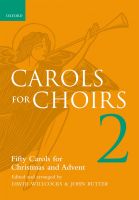1) Tomorrow shall be my dancing day;
I would my true love did so chance
To see the legend of my play,
To call my true love to my dance;
Ref.: Sing, oh! my love, oh! my love, my love, my love,
This have I done for my true love.
2) Then was I born of a virgin pure,
Of her I took fleshly substance
Thus was I knit to man's nature
To call my true love to my dance.
3) In a manger laid, and wrapped I was
So very poor, this was my chance
Betwixt an ox and a silly poor ass
To call my true love to my dance.
4) Then afterwards baptized I was;
The Holy Ghost on me did glance,
My Father’s voice heard I from above,
To call my true love to my dance.
5) Into the desert I was led,
Where I fasted without substance;
The Devil bade me make stones my bread,
To have me break my true love's dance.
6) The Jews on me they made great suit,
And with me made great variance,
Because they loved darkness rather than light,
To call my true love to my dance.
7) For thirty pence Judas me sold,
His covetousness for to advance:
Mark whom I kiss, the same do hold!
The same is he shall lead the dance.
8) Before Pilate the Jews me brought,
Where Barabbas had deliverance;
They scourged me and set me at nought,
Judged me to die to lead the dance.
9) Then on the cross hanged I was,
Where a spear my heart did glance;
There issued forth both water and blood,
To call my true love to my dance.
10) Then down to hell I took my way
For my true love's deliverance,
And rose again on the third day,
Up to my true love and the dance.
11) Then up to heaven I did ascend,
Where now I dwell in sure substance
On the right hand of God, that man
May come unto the general dance.
"Tomorrow Shall Be My Dancing-Day" ist ein englisches Weihnachtslied, das in der Regel als "traditionell" bezeichnet wird; sein erstes schriftliches Erscheinen findet sich in William B. Sandys' Christmas Carols Ancient and Modern von 1833. Es ist jedoch mit ziemlicher Sicherheit viel früher entstanden; Studwell (2006) ordnet es dem 16. Jahrhundert zu. Cahill (2006) spekuliert aufgrund der Formulierung "to see the legend of my play", dass der Text auf einer früheren Version beruhen könnte, die mit einem Mysterienspiel des späten Mittelalters in Verbindung gebracht wird.
Das Lied "Tomorrow shall be my dancing day" ist in 2 Liederbüchern enthalten:
| Cover | Liederbuch | Nummer | Noten |
 |
100 Carols for Choirs (1988) |
91 |
|
 |
Carols for Choirs 2 (1970) Fifty carols for christmas and advent |
47 |
|

